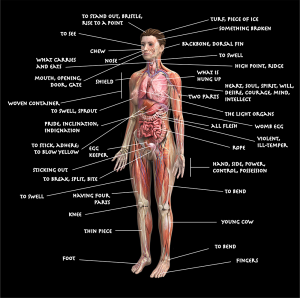 The origin of a word is fascinating, and the etymology of a word’s evolution tells a story. You can almost picture syllables and letters marching like armies through distant lands – Old England, Low Germany, Ancient Greece… or rising up from a dark, primordial world of shapeless magic to take form and structure.
The origin of a word is fascinating, and the etymology of a word’s evolution tells a story. You can almost picture syllables and letters marching like armies through distant lands – Old England, Low Germany, Ancient Greece… or rising up from a dark, primordial world of shapeless magic to take form and structure.
I’ve changed the anatomic names of the human body on this diagram to tell the story of each organ’s epithet. As a primary source I used Online Etymology Dictionary, which is a labor of love created by Douglas Harper using the best classic sources. The fantastic 3D anatomy rendering is from Zygote Media Group. I found some of the derivations and etymologies quite thought-provoking, while others such as “knee” are simply stated. I had to do a lot of work with my “something broken” to compose this diagram, so please enjoy!
Brain – from the Celtic bhrag-no, or bran, “something broken”
Skull – Dutch schol “turf, piece of ice”
Hair – from PIE ghers– “to stand out, to bristle, rise to a point”
Eye – from Proto-Indo-European (from here on abbreviated as PIE) “to see”
Ear (Pinna) – from the Proto-Indo-European “backbone, dorsal fin”
Cheek – Old English ceowan “chew”
Nose – PIE nas, “nose”
Mouth – Old English muþ “mouth, opening, door, gate,”
Throat – Old Norse þrutna “to swell”
Neck – PIE knok– “high point, ridge”
Chest – from PIE kista “woven container”
Breast – PIE root bhreus– “to swell, sprout”
Heart – Old English heorte “heart; breast, soul, spirit, will, desire; courage; mind, intellect”
Aorta – Greek aorte, term applied by Aristotle, literally “what is hung up,”
Lungs – Proto-Germanic lungw, “the light organ.” It is speculated that this derives from the fact that lungs of a slaughtered animal float in water, while the heart, liver, etc., do not.
Esophagus – from Greek oisophagos “gullet,” literally “what carries and eats”
Stomach – Latin stomachus “stomach, throat,” also “pride, inclination, indignation”
Liver – PIE leip– “to stick adhere; fat”
Gallbladder – from PIE root ghel– “gold, yellow, yellowish-green” and PIE bhle– “to blow”, “to blow yellow, green”
Pancreas – Latinized form of Greek pankreas, from pan– “all” (see pan-) + kreas “flesh”
Kidney – perhaps a compound of Old English cwið “womb” + ey “egg”
Intestines – Old English hropp, literally “rope”
Spleen – from Greek splen, associated with “violent, ill-temper”
Ovary – classical Latin, ovarius, “egg-keeper”
Uterus – PIE root udero, “sticking out”
Vagina – PIE wag-ina – from root *wag- “to break, split, bite”
Penis – from Latin penis, “tail”
Thigh – PIE teuk– from root teu – “to swell”
Quadriceps – Latin quadriceps, “having four parts”
Leg – PIE root meaning “to bend”
Knee – well, basically Latin genu “knee”
Calf – Old English cealf – “young cow”
Ankle – PIE root ang-/ank– “to bend”
Foot – Proto-Germanic fot, “foot”
Toes – from Proto-Germanic taikhwo, “fingers”
Shin – Proto-Germanic skino, “thin piece”
Arm – PIE root ar – “fit, join”
Shoulder – West Germanic skuldro, shield
Biceps – Latin biceps “having two parts”
Elbow – Old English elnboga, from ell “length of the forearm” + boga “bow, arch”
Hand – Old English hond, hand “hand; side; power, control, possession”
Finger – PIE penkwe, the root meaning “five”

Found this on Zite app this morning. Truly appreciate the different perspectives on anatomy. I’ve been a fascia geek the past decade and still find it fascinating to be talking about the middle jiao with acupuncturists… It’s still the hara, the enteric nervous system, the second brain, our emotional center…
Mizu. Agua. Water. Same ol’ stuff.
Thanks for the post!
That is awesome to see! Greeks may have had some interesting views on human anatomy but they did provide a lot of what we know today. Thanks for sharing!
Really a fun post. I always enjoy your writing, and this is another great example. Thanks.
Such an amazing post, these are all so cool to see how body parts were thought of in older times. Thanks for sharing!
Have you heard of Grimm’s law? It essentially governs the consonant changes that appear in Germanic languages as they developed from Indo-European. It describes the changes that appear in consonants called stops. The consonants come in three types: voiced, unvoiced, and fricative, and can be made in three parts of the mouth: labial, dental, and velar.
The stops are:
labial: B (voiced), P (unvoiced), F (fricative; think ph as in phone)
dental: D (voiced), T (unvoiced), TH (fricative; unvoiced, as in thin)
velar: G (voiced), K (unvoiced), CH (fricative, as in the German, ich)
The rule is as follows: voiced –> unvoiced; unvoiced –> fricative; fricative –> voiced.
Now, look at the Greek root, kard- (as in cardiac), meaning heart. It has two stops: K and D. Apply Grimm’s law. What happens? K becomes CH and D becomes T. Kard –> chart (but the ch is not like ch as in church, but more like an H, as in the German, ich); it essentially becomes “hart.”
Look, too, at the Greek pod- (as in podiatry), meaning foot. It has two stops, P and D. Apply Grimm’s law and what happens? P becomes F and D becomes T. Pod –> fot, the proto-germanic, “foot.”
Pretty cool, no?
Thanks for the comments, fascinating really, and add a lot to the topic!